Module 5 Intro
| Site: | MoodleHUB.ca 🍁 |
| Course: | Biology 20 SS |
| Book: | Module 5 Intro |
| Printed by: | Guest user |
| Date: | Friday, 28 November 2025, 6:49 AM |
Description
Created by IMSreader
Table of contents
- 1. Module 5 Intro
- 1.1. Big Picture
- 1.2. In this Module
- 1.3. Lesson 1 Intro
- 1.4. Page 2
- 1.5. Page 3
- 1.6. Page 4
- 1.7. Page 5
- 1.8. Page 6
- 1.9. Lesson 2 Intro
- 1.10. Page 2
- 1.11. Lab
- 1.12. Page 4
- 1.13. Page 5
- 1.14. Page 6
- 1.15. Lesson 3 intro
- 1.16. Page 2
- 1.17. Page 3
- 1.18. Page 4
- 1.19. Lesson 4 Intro
- 1.20. Page 2
- 1.21. Page 3
- 1.22. Page 4
- 1.23. Page 5
- 1.24. Lesson 5 Intro
- 1.25. Page 2
- 1.26. Page 3
- 1.27. Page 4
- 1.28. Page 5
- 1.29. Lesson 6 Intro
- 1.30. Page 2
- 1.31. Page 3
- 1.32. Page 4
- 1.33. Page 5
- 1.34. Lesson 7 Intro
- 1.35. Page 2
- 1.36. Lab
- 1.37. Page 4
- 1.38. Page 5
- 1.39. Page 6
- 1.40. Module Glossary
1. Module 5 Intro
Module 5—Photosynthesis and Cellular Respiration
Module Introduction
The major concepts developed in this module will lead your exploration of the cellular processes of photosynthesis and cellular respiration. These two processes provide the energy and matter required for the survival of all organisms on Earth. You will relate photosynthesis to the storage of energy in organic compounds. You will also explore the role of cellular respiration in releasing potential energy from organic compounds. You will be drawing on what you have already learned about these processes and the cell structures involved from Science 7, 8, and 10. You will also build upon the concept of energy flow and matter exchange that was developed in Unit A. In this module, instead of looking at an entire ecosystem or biosphere, you will be looking at the starting point of energy and matter exchange at the cellular level.
How does photosynthesis absorb solar energy? Photosynthesis will be broken down into more complex reactions. You will learn how pigments are involved in energy absorption. You will explore how compounds gain and lose electrons in the process of energy transfer to provide energy for photosynthesis and for the production of glucose.
How do organisms harness the energy from photosynthesis? You will investigate different kinds of cellular respiration. You will again explore how compounds gain and lose electrons during this process.
Lessons in this module will guide your discovery of the application of technology to benefit humans. You will also look at how humans may have unintentionally impacted photosynthesis and cellular respiration.
By the end of this module you will have completed activities that are to be marked by your teacher and others that help to build confidence in your ability to understand, interpret, and express key course concepts. Everything should be saved in your course folder so that you are able to review pieces of information for exams, unit assessments, or discussions. For example, once you have completed this module, you will be required to do a three-part unit assessment. You will answer questions from the textbook, create some multiple-choice questions, and look at the effects of a herbicide on photosynthesis and cellular respiration. When you are ready to complete the unit assessment you will find the project description and marking rubrics in the Module Summary and Unit Assessment.
1.1. Big Picture
Module 5—Photosynthesis and Cellular Respiration
 Big Picture
Big Picture
People have a need for energy. Energy is required to run everything from a huge power plant to a single cell. Luckily, people have access to an unlimited energy supply—the Sun. Essentially, all available energy on the planet is derived from the Sun. Earth’s entire biosphere has evolved as an ultra-efficient means to transform solar rays into the chemical energy required for life. Plants have evolved to transform solar energy to potential chemical energy. Animals, such as humans, have evolved to transfer potential chemical energy into many other energy forms.
Science and technology are important in today’s society. This is particularly so with concerns over the rising environmental and economic costs of limited non-renewable energy sources and with the deforestation of large tracts of vegetation.
Technology is produced to enhance or mimic the processes of photosynthesis and cellular respiration. What fundamental principles are the basis for this research and technological advancement?
© Uli Hamacher/iStockphoto

As you discovered in Unit A, massive vegetation equals high plant productivity. Increasing population pressures may create havoc on Earth by reducing the amount of vegetation and, thus, the ability for photosynthesis to support the biosphere. Therefore, it is essential to understand the minute details of the process of photosynthesis and exploit it. What are the opportunities for applying what is known about photosynthesis?
Photosynthesis-based technology could include using the concept of efficient "energy capture" to artificial systems just as plants have been doing. Research is being done in Berkeley, California, on getting green algae to convert water to hydrogen to be harnessed as a
clean-burning fuel. Currently, technology has developed herbicides that inhibit photosynthesis in order to kill weeds.
The value of applying knowledge of cellular respiration has also been utilized in the multi-billion dollar wine industry. Globally, 27 billion litres of wine are made each year. This is an industry where new technologies are being developed to enhance cellular respiration and photosynthesis for the benefit of taste and economics.
Photosynthesis and cellular respiration are the most important biological processes on Earth. Without these two processes, how would the transfer of energy and matter occur?
You will explore the following essential questions in this module:
- What pathways do energy and matter follow in living organisms?
- How does the energy from light flow through living systems?
- Why is oxygen produced during photosynthesis?
- How is carbon dioxide used during the light-independent reactions of photosynthesis?
- How are ATP and NADPH produced by the light-dependent reactions used to make glucose?
As there is only one module in Unit C, there is only a unit assessment for you to consider as you work through Module 5.
As you work through the module, make note of questions or concepts that were particularly challenging or thought-provoking. This list will be helpful when you are ready to complete a unit test as part of your Unit Assessment. You will find the details for this assessment and an evaluation rubric in the Unit Summary section.
1.2. In this Module
Module 5—Photosynthesis and Cellular Respiration
In This Module
Lesson 1—An Introduction to Photosynthesis and Cellular Respiration
If you want to live on Mars, you need to know the basics of photosynthesis and cellular respiration. Understanding these two processes will help you produce the food you will eat and the oxygen you will breathe during your stay on Mars. In this lesson you will review the basics of photosynthesis and cellular respiration. Can you name two organelles that are the sites for photosynthesis and cellular respiration? Lesson 1 will help you review cell structures and functions. You will also review the various mechanisms used for transporting materials in and out of cells, along with the role of ATP. You will be introduced to new vocabulary so that it becomes more familiar to you as you work through this module. As you will find in the following lessons, these topics are very important to help develop a full understanding of photosynthesis and cellular respiration.
- What pathways do energy and matter follow in living organisms?
Lesson 2—Light-Dependent Reactions
Have you ever forgotten to open your window blinds before going on vacation? What happened to your plants? You may have made this mistake despite knowing that your plants need water and sunlight to grow. In this lesson you will explore the specific role of water and sunlight in photosynthesis. This lesson introduces the light-dependent reactions of photosynthesis that release oxygen.
- How does the energy from light flow through living systems?
- How does oxygen become a product of photosynthesis?
Lesson 3—The Light-Independent Reactions of Photosynthesis
Does photosynthesis stop if you turn off the lights? Part of photosynthesis occurs when light is not available. This lesson introduces the light-independent reactions of photosynthesis where carbon dioxide is used to produce glucose.
- How is carbon dioxide used during the light-independent reactions of photosynthesis?
- How are ATP and NADPH produced by the light-dependent reactions used to make glucose?
Lesson 4—Investigating Photosynthesis
In this lesson you will further explore photosynthesis.
- What factors affect photosynthesis?
- What technologies have emerged from photosynthesis-based research?
Lesson 5—Anaerobic Respiration
What, no oxygen? No problem. Cellular respiration can still occur, but much less efficiently. This lesson introduces anaerobic cellular respiration. Not only will you learn about those pesky leg cramps that occur in the middle of a race, but you will also determine how alcohol and bread are made.
- How far can cellular respiration go without the presence of oxygen?
- How does anaerobic respiration release potential energy from organic compounds?
Lesson 6—Aerobic Respiration
Oxygen is the gas that allows you to survive! People actually need oxygen to efficiently obtain energy from sugar molecules. This lesson introduces the aerobic stage of cellular respiration.
- How does the presence of oxygen affect cellular respiration?
- How does aerobic cellular respiration release potential energy from organic compounds?
Lesson 7—Investigating Cellular Respiration
In this lesson you will further explore cellular respiration.
- How can you demonstrate quantitatively that germinating seeds consume oxygen?
- How do metabolic toxins affect cellular respiration?
1.3. Lesson 1 Intro
Module 5—Photosynthesis and Cellular Respiration
Lesson 1—An Introduction to Photosynthesis and Cellular Respiration
 Get Focused
Get Focused
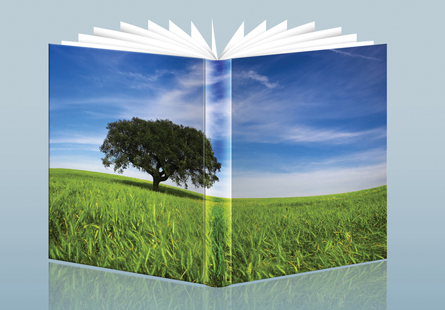
© Mario Lopes/shutterstock
In Unit B you learned that photosynthesis and cellular respiration influence the cycling of matter and the transformation of energy in the biosphere. In order to learn more about these processes, you will need to review your understanding of cells and cellular transport. You will also be introduced to ATP, which is involved in photosynthesis and cellular respiration, as well as energy pathways such as electron transport chains. These bits of information will help you understand the concepts in the following lessons.
In this lesson you will explore the following essential question:
- What pathways do energy and matter follow in living organisms?
Module 5: Lesson 1 Assignment
Your teacher-marked Module 5: Lesson 1 Assignment requires you to submit a response to the following:
- TR 2. The Chloroplast and the Mitochondrion
- Reflect and Connect
You can access your Module 5: Lesson 1 Assignment. You can print off the assignment or save the download to your computer. Your answers can be saved on this document to your course folder.
The other questions in this lesson are not marked by the teacher; however, you should still answer these questions. The Self-Check and Try This questions are placed in this lesson to help you review important information and build key concepts that may be applied in future lessons.
After a discussion with your teacher, you must decide what to do with the questions that are not part of your assignment. For example, you may decide to submit to your teacher the responses to Try This questions that are not marked. You may decide to record the answers to all the questions in the lesson and place those answers in your course folder.
1.4. Page 2
Module 5—Photosynthesis and Cellular Respiration
 Explore
Explore
 Read
Read
In Science 10 you studied cell theory, cell structure, and cell function. In this lesson you will build on those basics toward a greater understanding of cellular respiration and photosynthesis.
If you need to review cells, read pages 154 and 155 of the textbook. In particular, review the labelled diagrams of cells so that you have a better idea of where photosynthesis and cellular respiration take place. Once you have reviewed these pages, complete the following Try This.
 Try This
Try This
TR 1. The Cell
Can you identify the mitochondrion and the chloroplast? Scroll over these two diagrams to see if you can correctly identify these structures. You will be learning more about these structures as you move through this module.
 Read
Read
The Chloroplast and the Mitochondrion
Chloroplasts and mitochondria have unique designs that allow them to carry out photosynthesis and cellular respiration. Plant cells have both a chloroplast and a mitochondrion, while animal cells contain only a mitochondrion.
 Try This
Try This
TR 2. The Chloroplast and the Mitochondrion
Go to your Module 5: Lesson 1 Assignment. Use the information provided on pages 164 and 165 of the textbook to label the structures of the chloroplast and mitochondrion. On your diagram, add descriptions of the function of the parts you have labelled.
 Read
Read
passive transport: no energy required
diffusion: a process in which molecules move from areas of high concentration to low concentration
facilitated diffusion: a process in which larger molecules need the help of proteins in cell walls to move from areas of high concentration to low concentration
osmosis: the diffusion of water across a semipermeable membrane
active transport: a process that requires energy from ATP to move substances against the concentration gradient
endocytosis: a process in which cell membranes engulf a substance and pinch off inside the cell
pinocytosis: a process in which the cell wall engulfs liquids and their solutes and pinches off inside the cell
phagocytosis: a process in which the cell wall engulfs a large particle, such as bacteria or a blood cell, and pinches off inside of the cell
exocytosis: a process in which a vacuole containing substances from inside a cell (cytoplasm) fuses with the cell wall and the contents are released outside of the cell
Cells must transport molecules produced during photosynthesis and cellular respiration. Cells must also transport the required compounds for these two processes. Note these types of cellular transport:
- passive transport
- diffusion
- facilitated diffusion
- osmosis
- active transport
- endocytosis
- pinocytosis
- phagocytosis
- exocytosis
These methods of transport move substances across the cell membrane. Membranes exist in every organelle. Transport of materials happens across the membranes of the mitochondrion and the cell. Using information from the glossary definitions and pages 156 to 159 of the textbook, try the following Self-Check.
 Self-Check
Self-Check
SC 1. Complete this Self-Check activity.
 Self-Check
Self-Check
SC 2. What is the purpose of facilitated diffusion?
SC 3. Where does a cell get energy for active transport?
 Self-Check Answers
Self-Check Answers
SC 2. Facilitated diffusion moves large molecules down the concentration gradient. These molecules are unable to diffuse across the cell membrane because of their size.
SC 3. Cells get energy from ATP (adenosine triphosphate) when phosphate bonds are broken.
 Read
Read
What is ATP?
ATP (adenosine triphosphate): a
high-energy phosphate molecule that provides and stores the energy required for cellular functions
Photosythesis produces the energy-rich chemical compound of glucose. The by-products of photosynthesis are oxygen and some ATP. Cellular respiration breaks down energy-rich compounds such as glucose. Breaking down the chemical bonds in glucose generates ATP. Cellular respiration generates more ATP than photosynthesis.
ATP is the energy currency of cells—when cells need energy, they spend ATP. You will learn more about ATP synthesis later on in this module.
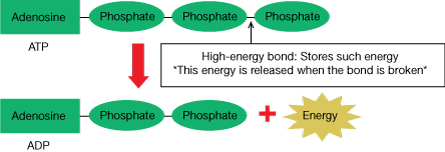
Read “ATP and Cellular Activity” on page 163 of the textbook.
 Self-Check
Self-Check
SC 4. What is ATP used for?
SC 5. How does ATP supply energy to the cell?
 Self-Check Answers
Self-Check Answers
SC 4. ATP is used for active transport, cell division, movement, muscle contraction, and the synthesis of proteins and other molecules.
SC 5. Energy is released when the bond to the third phosphate group breaks. This energy fuels cellular function.
1.5. Page 3
Module 5—Photosynthesis and Cellular Respiration
 Read
Read
Metabolic Pathways
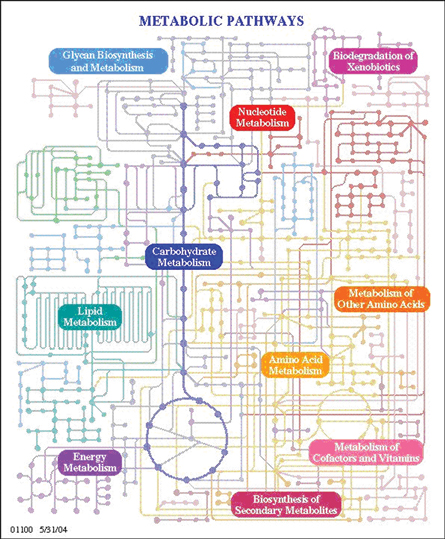
© Dept. of Computer Science, University of Helsinki. Used with permission.
metabolism: all of the chemical reactions that occur within a cell to support and sustain its life functions
This can be the synthesis of molecules or the breaking down of molecules for energy.
Metabolic pathways are interconnected and involve many steps. Plants and animals rely on metabolic pathways to store and provide energy. These pathways can be summarized by the word metabolism.
Photosynthesis and cellular respiration are two important pathways. They can be represented by the following two formulas:
6 CO2(g) + 6 H20(l) + energy → C6H12O6(s) + O2(g)
C6H12O6(s) + O2(g) → 6 CO2(g) + 6 H20(l) + energy
The important thing to keep in mind is that these are summary statements. Both processes are a series of reactions that use initial reactants to produce final products.
The series of reactions becomes a metabolic pathway. Metabolic pathways transfer energy and cycle matter. The products of one reaction become the reactants for the next reaction. You will be learning about the series of reactions in the following lessons.
 Self-Check
Self-Check
SC 6. True or False: Cellular respiration is the same as breathing.
 Self-Check Answer
Self-Check Answer
SC 6. False. Cellular respiration is how the cell derives useable energy from glucose. Breathing, which is fuelled by the energy of cellular respiration, refers to the gas exchange of CO2 and O2. These elements are necessary products and reactants for cellular respiration.
1.6. Page 4
Module 5—Photosynthesis and Cellular Respiration
 Read
Read
REDOX
oxidation: a loss of electrons
reduction: a gain of electrons
Oxidation and reduction, oxidized and reduced. These are words that you will encounter as you learn more about photosynthesis and cellular respiration. Read page 167 in your textbook.
The words reduction or reduced can sometimes create confusion. Normally one would associate the idea of less with these words; but instead, there is a gain. How does this work?
There is a simple mnemonic device to remember the definition of the terms oxidation and reduction. All you have to do is remember that LEO the lion goes GERRR! (That is a growl.) Spelled out, it looks like this:
Lose Electrons → Oxidation, Gain Electrons → Reduction
redox reaction: a reaction involving the transfer of electrons
When electrons transfer in a chemical equation, this is called a redox reaction. Here is a chemical equation to illustrate.
Xe- + Y → X + Ye-
Reduction: Carbon dioxide gains electrons and hydrogen to become glucose. It is reduced.
Oxidation: Water loses electrons and loses hydrogens to become oxygen. It is oxidized.
It turns out that the overall reaction of photosynthesis is an oxidation-reduction (redox) reaction. In the first step, the oxygen in water is oxidized by the light energy. This means that the water molecule has lost electrons (LEO). You will learn more about this process when you study light-dependent reactions.
H2O + light energy→1/2 O2 + 2 [H.]+ 2 e-
proton: a hydrogen ion containing one electron
Here, [H.], or a proton, represents a reducing agent. Next, the [H.] reduces the carbon in CO2. This is not as simple as is shown. However, the idea is that at some point carbon dioxide is reduced (GER). The result is a charboydrate molecule. You will learn about this step during your study of light-independent reactions.
2[H.] + CO2 → (CH2O){carbohydrate molecule}
Note: In order for a glucose molecule to be created, more than one water molecule and one carbon dioxide molecule are involved. This situation is indicated by the balanced chemical equation
6 CO2(g) + 6 H20(l) + energy → C6H12O6(s) + O2(g)
Conversely, in cellular respiration, glucose is oxidized and oxygen is reduced.
 Self-Check
Self-Check
SC 7. A molecule such as NADP+ can be reduced to NADPH. NADPH is said to have reducing power. What does this mean?
SC 8. Hydrogen ions are also called ______________.
SC 9. True or False: [H+] has one electron.
 Self-Check Answers
Self-Check Answers
SC 7. NADPH has more available stored energy because it has gained electrons. It has more power.
SC 8. Hydrogen ions are also called protons.
SC 9. True. Protons carry one electron and can reduce a compound because a proton will add an electron (GER).
 Watch and Listen
Watch and Listen
What is an electron transport chain?
You will be introduced to an electron transport chain in the following animation. In an electron transport chain, electrons pass from carrier to carrier through a series of oxidation-reduction reactions. During each transfer, some energy is released.
chemiosmosis: the process by which ATP is generated through the movement of protons down a concentration gradient
The protons move across the inner membranes to the mitochondrion and thylakoid membrane of the chloroplast and combine with ADP and phosphate molecules to form ATP.
Electron transport chains are essential to photosynthesis and cellular respiration. In an electron transport system, energy from electron transfer during oxidation-reduction reactions enables certain carriers to pump protons (H+) across a membrane. As the H+ concentration increases on one side of the membrane, an electrochemical gradient develops and chemiosmosis occurs.
Watch the following animation to get an idea of what chemiosmosis looks like.
1.7. Page 5
Module 5—Photosynthesis and Cellular Respiration
 Reflect and Connect
Reflect and Connect
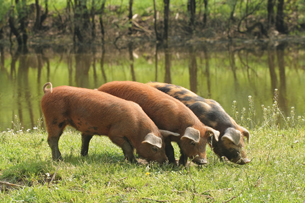
© Jasenka Lukša/shutterstock
As you worked through this lesson, were you able to create a better mental picture of what happens during photosynthesis and cellular respiration?
Go to the Module 5: Lesson 1 Assignment to answer some questions about matter, energy, photosynthesis, and cellular respiration.
 Module 5: Lesson 1 Assignment
Module 5: Lesson 1 Assignment
Remember to submit the Assignment answers to your teacher as part of your Module 5: Lesson 1 Assignment.
1.8. Page 6
Module 5—Photosynthesis and Cellular Respiration
 Lesson Summary
Lesson Summary
In this lesson you explored the following essential question:
- What pathways do energy and matter follow in living organisms?
Energy and matter follow many pathways. Matter is transported in many different ways. Osmosis and active transport are two ways that you explored—both are involved in photosynthesis and cellular respiration.
The most important metabolic pathways for plants are photosynthesis and cellular respiration. Cellular respiration is the most important metabolic pathway for humans. These pathways break down or synthesize carbon dioxide, water, carbohydrates, oxygen, and ATP (energy). The creation or breakdown of these important molecules is reliant on oxidation-reduction reactions. These reactions occur via electron transport systems and chemiosmosis in the mitochondrion and chloroplast.
Lesson Glossary
active transport: a process that requires energy from ATP to move substances against the concentration gradient
ATP (adenosine triphosphate): a high-energy phosphate molecule that provides and stores the energy required for cellular functions
chemiosmosis: the process by which ATP is generated through the movement of protons down a concentration gradient
The protons move across the inner membranes to the mitochondrion and thylakoid membrane of the chloroplast and combine with ADP and phosphate molecules to form ATP.
diffusion: a process in which molecules move from areas of high concentration to low concentration
endocytosis: a process in which cell membranes engulf a substance and pinch off inside the cell
exocytosis: a process in which a vacuole containing substances from inside a cell (cytoplasm) fuses with the cell wall and the contents are released outside of the cell
facilitated diffusion: a process in which larger molecules need the help of proteins in cell walls to move from areas of high concentration to low concentration
metabolism: all of the chemical reactions that occur within a cell to support and sustain its life functions
This can be the synthesis of molecules or the breaking down of molecules for energy.
osmosis: the diffusion of water across a semipermeable membrane
oxidation: a loss of electrons
passive transport: no energy required
phagocytosis: a process in which the cell wall engulfs a large particle, such as bacteria or a blood cell, and pinches off inside of the cell
pinocytosis: the cell wall engulfs liquids and their solutes and pinches off inside the cell
proton: a hydrogen ion containing one electron
redox reaction: a reaction involving the transfer of electrons
reduction: a gain of electrons
1.9. Lesson 2 Intro
Module 5—Photosynthesis and Cellular Respiration
Lesson 2—Light-Dependent Reactions
 Get Focused
Get Focused
You may wonder what role plants play in supporting your life on Earth, other than being an obvious supplier of oxygen through photosynthesis. Plants are used for making medicines, perfumes, lotions, clothes, paper, and buildings. People also use plants as a source of amino acids, food energy, and oxygen. In short, plants are a pretty big deal.
A knowledge of photosynthesis may become valuable in the future if Earth experiences food or fuel shortages. By understanding photosynthesis, technologies that could help alleviate these shortages can be explored.
What is the first thing you think of when you hear the word photosynthesis? Some words that come to mind might be green, plants, and
sun. Plants do require sunlight to perform one part of photosynthesis. You will be studying the light-dependent reactions of plants.
In this lesson you will explore the following essential questions:
- How does the energy from light flow through living systems?
- How does oxygen become a product of photosynthesis?
 Module 5: Lesson 2 Assignment
Module 5: Lesson 2 Assignment
Your teacher-marked Module 5: Lesson 2 Assignment requires you to submit a response to the following:
- LAB: Using Chromatography to Separate Plant Pigments
- Reflect and Connect
You can access your Module 5: Lesson 2 Assignment. You can print off the assignment or save the download to your computer. Your answers can be saved on this document to your course folder.
You must decide what to do with the questions that are not marked by the teacher.
Remember that these questions provide you with the practice and feedback that you need to successfully complete this course. You should respond to all the questions and place those answers in your course folder.
1.10. Page 2
Module 5—Photosynthesis and Cellular Respiration
 Explore
Explore
 Read
Read
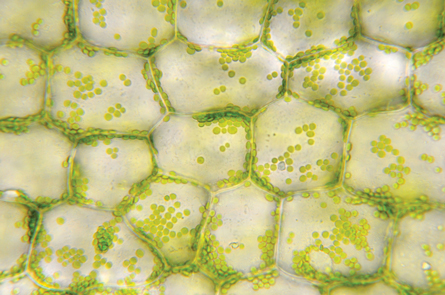
© Nancy Nehring/iStockphoto
Where does photosynthesis occur?
In Lesson 1 you studied the chloroplast and learned to identify its structures and functions. As you begin to explore the light-dependent reactions of photosynthesis, you will be focusing on the reactions that happen in the thylakoid membrane.
thylakoid membrane: flattened stacks within the stroma that contain chlorophyll
Chlorophyll is the light-capturing pigment that absorbs all wavelengths of light except for green and some yellow. Read “The Light-Dependent Reactions of Photosynthesis” on page 170 of the textbook. Make note of the graphs and diagrams on page 171. You may also want to revisit the Module 1: Lesson 1 Assignment, where you completed a virtual experiment discussing factors that affect photosynthesis. One factor discussed was light wavelengths.
A Closer Look at Chloroplasts

The flattened thylakoids in the chloroplasts of plant cells are stacked into columns called grana. Surrounding the thylakoids and filling the interior of the chloroplast is the fluid stroma, which is where the chemical reactions that synthesize carbohydrates take place.
Light-reflecting and Light-absorbing Characteristics of Pigments
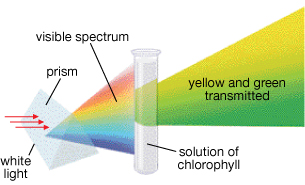
When you look at an object, you see the colours that were not absorbed by the object.
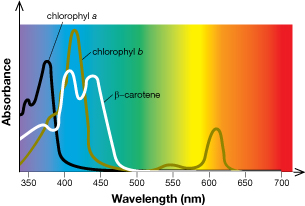
This absorbance spectrum for three photosynthetic pigments shows that each pigment absorbs a different combination of colours of light.
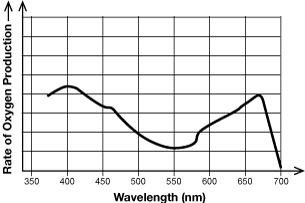
This action spectrum for photosynthesis shows the rate at which oxygen is produced during photosynthesis. Notice that the shape of the graph line generally mirrors the shape of the graph lines in the absorbance spectra above.
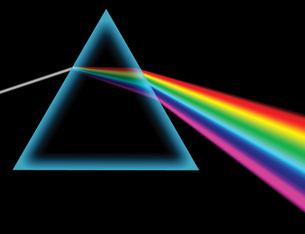
© YAKOBCHUK VASYL/shutterstock
 Self-Check
Self-Check
SC 1. Why do plants appear green?
SC 2. What is the difference between chlorophyll a, chlorophyll b, and beta carotene?
SC 3. Why would it be an advantage for a plant to have several pigments in a chloroplast?
SC 4. At what wavelength of light is oxygen production the lowest? Highest?
 Self-Check Answers
Self-Check Answers
SC 1. Plants appear green because chlorophyll reflects the wavelength of light that produces green light and absorbs the other wavelengths.
SC 2. Chlorophyll a absorbs more indigo, violet, and red wavelengths. Chlorophyll b absorbs more blue and orange wavelengths. Beta carotene absorbs violet, indigo, blue, and green wavelengths, but not yellow, orange, or red wavelengths.
SC 3. Having a variety of pigments enables a plant to use a greater percentage of the Sun’s light.
SC 4. Oxygen production is the lowest between 500 and 550 nm (green-light wavelength). Oxygen production is highest between 400 and 475 nm (indigo/blue-light wavelengths).
1.11. Lab
Module 5—Photosynthesis and Cellular Respiration
 LAB. Using Chromatography to Separate Plant Pigments
LAB. Using Chromatography to Separate Plant Pigments
To identify the different pigments present in the leaves of a green plant, a separation process called chromatography is used. Your textbook gives a procedure for “Investigation 5.B: Using Chromatography to Separate Plant Pigments” on pages 172 and 173. If you have access to a lab, you may be instructed to complete this lab as indicated in the textbook. You should not attempt this investigation outside of a lab, since the solvent used is volatile, poisonous, and flammable.
If you do not have access to a lab, you will be given a diagram of pigments separated by chromatography in your assignment.
In this experiment, liquid from crushed leaves is painted onto special paper. The paper is then placed in a test tube containing a solvent. The solvent is absorbed up through the paper and, as the solvent rises, it separates the different pigments. Generally, the pigments with the smallest molecules will move through the paper the fastest, but results may differ when some solvents—or combinations of solvents—are used.
Before you go to your Module 5: Lesson 2 Assignment to complete this Lab, complete the following Self-Check on reference flow.
 Self-Check: Reference Flow
Self-Check: Reference Flow
(Rf) is a measure of how far a substance is transported in chromatography relative to the movement of the solvent used. It is calculated by dividing the distance a substance (pigment) moves by the distance the solvent moves.
![]()
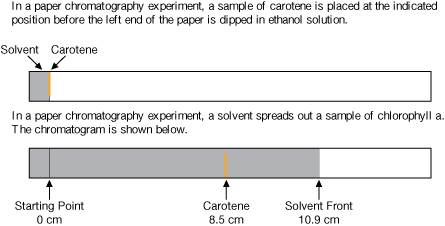
SC 5. Using the measurements shown on the diagram, what is the Rf for carotene?
 Self-Check Answer
Self-Check Answer
SC 5. Rf = 8.5 cm/10.9 cm = 0.78
1.12. Page 4
Module 5—Photosynthesis and Cellular Respiration
 Read
Read
The Path of Electrons in Light-Dependent Reactions
You may choose to read the following description or read pages 172 to 174 of the textbook before you watch the animation “Oxygenic Photosynthesi” in the next Watch and Listen. This animation clearly shows the path of electrons in the light-dependent reactions of photosynthesis.
photosystem: a cluster of light-absorbing pigment molecules in the thylakoid membrane of chloroplasts
NADP+: nicotinamide adenine dinucleotide phosphate in its oxidized state
NADPH: nicotinamide adenine dinucleotide phosphate in its reduced state; used in light-independent reactions to form glucose
ATP synthase: an enzyme that bonds free phosphates to ADP to form ATP
The electron transport chain that exists in the thylakoid membrane involves photosystem I and II. Photosystem II (PSII) absorbs all wavelengths of light allowed by its pigments. When light is absorbed, energy is transferred to a designated reaction-centre molecule. The reaction centre becomes “excited.” This means that an electron will want to move to a higher energy level, so the electron leaves to catch the electron-transport chain. PSII oxidizes water molecules to provide hydrogen ions for chemiosmosis and electrons to replace the electrons leaving the “reaction centre.” Oxygen is produced at this step.
The electron from photosystem II travels down the electron-transport chain. Every encounter with an electron-carrying molecule releases energy. This energy pushes H+ from the stroma into the thylakoid space. A hydrogen ion concentration gradient is formed. This gradient will be used to produce ATP from ADP (adenosine diphosphate) and free phosphate groups.
The e- (electron) from photosystem II reaches photosystem I (PSI). Light has also been absorbed by PSI. The energy has been passed on to the reaction centre. A highly energized electron leaves photosystem I to be replaced by the e- from PSII at the end of its electron-transport chain. The highly energized electron from PSI moves down an electron-transport chain. The electron is used to reduce NADP+ to form NADPH. NADP+ gains electrons from PSI and hydrogen ions.
Lastly, remember that hydrogen ions are building up in the thylakoid space. Once a hydrogen ion is in the thylakoid space, it cannot diffuse back to the stroma. However, ATP synthase embedded in the thylakoid membrane will move H+ down the concentration gradient (high [H+] in the thylakoid space to low [H+] in the stroma). The energy from this concentration gradient is chemiosmosis. ATP is created.
Light-dependent reactions produce oxygen, which is released from chloroplasts to the atmosphere. Light-dependent reactions produce intermediate products of NADPH and ATP. These molecules are required in light-independent reactions for the production of glucose.
The following diagram is a summary.
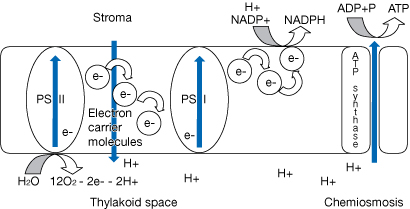
 Watch and Listen
Watch and Listen
The Path of Electrons in Light-Dependent Reactions
Watch the animation “Oxygenic Photosynthesis” or watch the animation “Photosynthetic Electron Transport and ATP Synthesis.” Note that these animations label molecules in the electron-transport chain that you are not required to know. You just need to realize these molecules are electron-carrying molecules. However, the molecules clearly show the path of electrons in the light-dependent reactions of photosynthesis. You may want to refer to a copy of the summary diagram as you watch the animation.
If you prefer to be in control of the animation speed, select “Oxygenic Photosythesis.” If you prefer to have audio with an animation, watch “Photosynthetic Electron Transport and ATP Synthesis.”
Now watch this Cyclic and Noncyclic Photophosphorylation animation. Which animation helped you better understand the light-dependent reactions of photosynthesis? Did the reading and/or diagram help you as well?
 Self-Check
Self-Check
SC 6. Complete this Self-Check activity to check your understanding of light-dependent reactions.
1.13. Page 5
Module 5—Photosynthesis and Cellular Respiration
 Reflect and Connect
Reflect and Connect
Go to your Lesson 2 Assignment to answer two questions about photosynthesis.
 Reflect on the Big Picture
Reflect on the Big Picture
Brainstorm a list of potential technologies based on photosynthesis that could be explored. Maybe these technologies are being explored already. Perform a web search to see what you can find. Save your list to your course folder to be revisited later in this module.
Summarize in point form, by illustration, by podcast, or by poem the events that take place in the light-dependent reactions of photosynthesis.
 Module 5: Lesson 2 Assignment
Module 5: Lesson 2 Assignment
Remember to submit the Assignment answers to your teacher as part of your Module 5: Lesson 2 Assignment.
1.14. Page 6
Module 5—Photosynthesis and Cellular Respiration
 Lesson Summary
Lesson Summary
In this lesson you explored the following essential questions:
-
How does the energy from light flow through living systems?
-
Why is oxygen produced during photosynthesis?
In order for photosynthesis to occur, there has to be light energy. There also has to be a way to harness light, because light travels at many different wavelengths. To account for this, plants contain many different pigments in their chloroplasts. To show this, you worked through a chromatography investigation.
Plants contain pigments, such as chlorophyll, that absorb all wavelengths of light except for greens, yellows, and some oranges (carotene). Once this light energy is absorbed, it is transferred to electrons that become highly excited and enter an electron-transport chain.
The production of oxygen happens when photosystem II oxidizes water molecules. Oxidized water molecules provide electrons for the electron-transport chain and hydrogen ions for chemiosmosis, or ATP Synthesis. Oxygen is a by-product that diffuses to the atmosphere. Photosystem I also transports highly-energized electrons and reduces NADP+ to NADPH.
In summary, the light-dependent reactions rely on the reactants of water and light energy. These reactions produce the end product of oxygen and the intermediate products of ATP and NADPH, which are used in light-independent reactions to produce glucose. You will discover the final step of photosynthesis in Lesson 3. As you can see, photosynthesis is a series of reactions more complex than the simple statement of
6 CO2(g) + 6 H20(l) + energy → C6H12O6(s) + O2(g)
Lesson Glossary
ATP synthase: an enzyme that bonds free phosphates to ADP to form ATP
NADP+: nicotinamide adenine dinucleotide phosphate in its oxidized state
NADPH: nicotinamide adenine dinucleotide phosphate in its reduced state; used in light-independent reactions to form glucose
photosystem: a cluster of light-absorbing pigment molecules in the thylakoid membrane of chloroplasts
reference flow: a measure of how far a substance is transported in chromatography
thylakoid membrane: flattened stacks within the stroma that contain chlorophyll
1.15. Lesson 3 intro
Module 5—Photosynthesis and Cellular Respiration
Lesson 3—The Light-Independent Reactions of Photosynthesis
 Get Focused
Get Focused
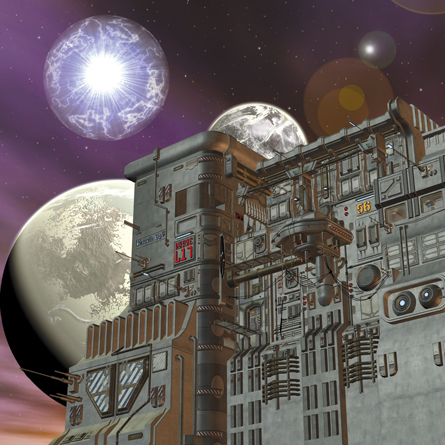
© Andreas Meyer/shutterstock
What if humans decide to colonize space? How could they apply information about photosynthesis to make colonization sustainable? In Lesson 2 you investigated how energy was converted during photosynthesis. You also know that plants absorb carbon dioxide and use it to make sugar.
In Lesson 3 you will study how plants are able to produce biomass.
“An estimated 170 billion tons of dry plant biomass is produced through photosynthesis by all plants on Earth each year. For every dry ton of new plant biomass produced through photosynthesis, approximately 1273 kg of oxygen are added to the atmosphere and approximately 1636 kg of carbon dioxide are removed. Studies conducted by the US and Russian space agencies show that astronauts consume approximately 0.9 kg of oxygen and exhale approximately 1.1 kg of carbon dioxide every 24 h. Based on this data, approximately 0.64 kg of new dry plant material must be produced by photosynthesis each day to supply the oxygen needs of one adult.”
Dr. B. C. Wolverton
Knowing how much plant matter is needed to produce enough oxygen to support life is valuable information. The values for oxygen production and carbon dioxide use stated in the previous quotation could be very helpful for scientists trying to design efficient crops or gardens able to sustain life in a space colony. Since the light-independent reactions of photosynthesis require carbon dioxide and produce biomass, this information is of great interest to researchers.
You may have noticed from the name of this process that light does not appear to be necessary. Does this mean that this series of reactions could happen without sunlight? As you work through this lesson, consider the necessary reactants for this step to occur and determine if they will be available to plants in space.
In this lesson the following essential questions will be examined:
- How is carbon dioxide used during the light-independent reactions of photosynthesis?
- How are ATP and NADPH produced by the light-dependent reactions used to make glucose?
 Module 5: Lesson 3 Assignment
Module 5: Lesson 3 Assignment
Your teacher-marked Module 5: Lesson 3 Assignment requires you to submit a response to the following:
- TR 1. You Be the Critic
- Reflect and Connect
You can access your Module 5: Lesson 3 Assignment. You can print off the assignment or save the download to your computer. Your answers can be saved on this document to your course folder.
You must decide what to do with the questions that are not marked by the teacher.
Remember that these questions provide you with the practice and feedback that you need to successfully complete this course. You should respond to all the questions and place those answers in your course folder.
1.16. Page 2
Module 5—Photosynthesis and Cellular Respiration
 Explore
Explore
 Read
Read
The Calvin-Benson Cycle
Calvin-Benson cycle: the process in which photosynthetic organisms fix carbon from atmospheric carbon dioxide to produce carbohydrates
carbon-dioxide fixation: a carbon atom in carbon dioxide is chemically bonded to a pre-existing 5-carbon compound in the stroma of the chloroplast
ribulose biphosphate (RuBP): a 5-carbon molecule in the stroma that initially bonds to carbon dioxide
ATP: a reduced high-energy adenosine triphosphate molecule
NADPH: a reduced nicotinamide adenine dinucleotide molecule
phosphoglyceraldehyde (PGAL): a high-energy compound used to make glucose
glucose: a saccharide or sugar; can be linked to many other saccharides to form different types of sugars or carbohydrates
As photosynthesis progresses to the light-independent reactions, these reactions move from the thylakoid space to the stroma of the chloroplast. It is not necessarily dark outside either.
Simply put, light-independent reactions do not directly depend on light energy in order to proceed. They do, however, depend on the products of the light-dependent reactions of NADPH and ATP. The energy contained in these two molecules is used in glucose synthesis.
Once again, there are a series of reactions that take place to synthesize carbohydrates (glucose). This series of reactions takes place in the Calvin-Benson cycle. The purpose of the cycle is for carbon-dioxide fixation. When studying the Calvin-Benson cycle, you will be introduced to the following familiar and unfamiliar molecules.
Ribulose biphosphate (RuBP) is a 5-carbon molecule in the stroma that initially bonds to carbon dioxide. After RuBP is bonded to carbon, it becomes unstable and breaks down into two 3-carbon molecules:
RuBP + C02 (g) → unstable C6 → 2 C3
The two low energy, 3-carbon molecules are activated by ATP and reduced by NADPH (gain electrons) to become high-energy phosphoglyceraldehyde (PGAL). Some molecules leave the cycle to create glucose, while other molecules remain in the cycle to replace RuBP.
Polysaccharides |
Uses |
starches (amylose/amylopectin) |
energy storage in plants |
glycogen (animal starch) |
energy storage in animals |
cellulose |
plant cell walls |
chitin |
arthropod |
The following diagram shows where these chemicals are needed in the Calvin-Benson cycle.
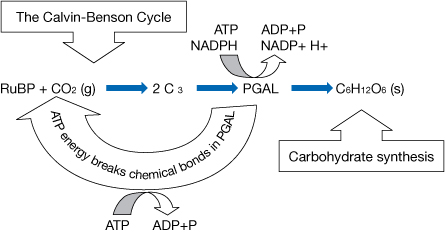
If you want to further explore the Calvin-Benson cycle, refer to “The Light-Independent Reactions of Photosynthesis” on pages 176 and 177 of the textbook. If you feel confident that you understand what is happening in the Calvin-Benson cycle, try answering the following Self-Check questions.
 Self-Check
Self-Check
SC 1. Complete this Self-Check activity to test your understanding of the Calvin-Benson cycle.
 Try This
Try This
TR 1. You Be the Critic
In the last two lessons you have learned a great deal about photosynthesis. View the following animation of photosynthesis.
You may think that some aspects of the animation seem overly simple and don’t explain the complexity of the process well enough. Why? What would you change or add?
Create a modified storyboard (PowerPoint) or a script that could be given to a multimedia developer to make this animation more suitable for you and your classmates. View the following template for ideas about how to create a storyboard.
Storyboard Template
Storyboard Template
What is a storyboard? Once a concept or script is written for a film or animation, the next step is to make a storyboard. A storyboard visually tells the story of an animation panel by panel, kind of like a comic book.
A storyboard will provide the following:
- a sequential shot list: This is a list of each visual shot, in order.
- a script or caption describing what is happening in the shot
- a visual: Storyboards are usually drawn in pen or pencil. If you don't like to draw, you can also take photos, cut out pictures from magazines, or use a computer to make your storyboards. Keep in mind that your drawings don’t need to be fancy! In fact, you want to spend just a few minutes drawing each frame. Use basic shapes, stick figures, and simple backgrounds.

Space will be provided in the Module 5: Lesson 2 Assignment to place your ideas. A rubric will be provided in the assignment as well.
 Self-Check
Self-Check
SC 2. Complete this Self-Check activity.
1.17. Page 3
Module 5—Photosynthesis and Cellular Respiration
 Reflect and Connect
Reflect and Connect
This lesson describes how the light-independent reactions of photosynthesis are responsible for the conversion of carbon dioxide into glucose. Although there are other processes that could be used to remove carbon dioxide from the air inside a space colony, not many other processes would be able to produce food at the same time.
Imagine that you are in charge of a greenhouse on a space station. The greenhouse has three purposes:
- to produce food
- to control air quality
- to provide fresh water
Prepare a large, detailed diagram to describe the greenhouse organization. How would each of the three listed purposes be performed? You may wish to consider what types of plants would be best to have in your greenhouse, as well as the light conditions and the atmospheric composition. Save this diagram in your course folder. This would be great to share with your classmates. Post your diagram and view the diagrams of other students. Review your response and make necessary edits.
 Discuss
Discuss
Global warming is an issue that emerges from many areas of biological study. You can describe the complex process of photosynthesis thanks to discoveries made by scientists.
If you were a scientist trying to stop global warming, what part of photosynthesis would you study? Why? Post your response in the discussion area. Your response should contain specific details and logical reasoning, instead of one general statement. Read other postings and save your response to your course folder. Did you learn anything new? Your teacher may use this as an Assessment item.
 Reflect on the Big Picture
Reflect on the Big Picture
Photosynthesis is an evolved process that has happened over millions of years. Scientists are working on ways to manipulate the evolution of photosynthesis in order to reduce global warming.
 Going Beyond
Going Beyond
How does biomass energy relate to photosynthesis? You discussed biomass in Unit A when you talked about biomass pyramids. You now know six carbon dioxide molecules are absorbed (assimilated) by photosynthetic organisms to produce one glucose molecule. These molecules become biomass. If you go to the CBC website, you can do a web search for a “Quirks and Quarks” radio episode on biomass. Use the following words in your search: “quirks quarks biomass September 16.” You are looking for the September 16, 2006, episode. Once you are on the page, scroll down until you find the title “Biomass.” The future of biomass fuels is discussed.
OR
What is RuBisCO? RuBisCO is the most abundant enzyme on Earth, but it is one of the most inefficient enzymes. Do a web search to find out what role RuBisCO plays in photosynthesis.
 Module 5: Lesson 3 Assignment
Module 5: Lesson 3 Assignment
Remember to submit the Assignment answers to your teacher as part of your Module 5: Lesson 3 Assignment.
1.18. Page 4
Module 5—Photosynthesis and Cellular Respiration
Lesson Summary
In this lesson the following essential questions were explored:
- How is carbon dioxide used during the light-independent reactions of photosynthesis?
- How are ATP and NADPH produced by the light-dependent reactions used to make glucose?
The Calvin-Benson cycle is the last step in photosynthesis. The purpose of the Calvin-Benson cycle is to take the energy from photosystem I and fix carbon. Carbon-dioxide fixation occurs when atmospheric CO2 (g) binds with a 5-carbon RuBP molecule to form two, 3-carbon PGAL molecules. ATP and NADPH, which are products from light-dependent reactions, provide energy and reducing power to form PGAL. Two PGAL molecules leave the Calvin-Benson cycle to form glucose, while the other molecules continue on to be broken down.
With the help of ATP, PGAL bonds are broken and RuBP is remade. This part of photosynthesis is responsible for removing carbon dioxide (a greenhouse gas) from the atmosphere—it is also responsible for the creation of biomass.
Applications of light-independent reactions may lead to the colonization of space, the reduction of global warming, or increased crop production.
Lesson Glossary
ATP: a reduced high-energy adenosine triphosphate molecule
Calvin-Benson cycle: the process in which photosynthetic organisms fix carbon from atmospheric carbon dioxide to produce carbohydrates
carbon-dioxide fixation: a carbon atom in carbon dioxide is chemically bonded to a pre-existing 5-carbon compound in the stroma of the chloroplast
glucose: a saccharide or sugar; can be linked to many other saccharides to form different types of sugars or carbohydrates
NADPH: a reduced nicotinamide adenine dinucleotide molecule
phosphoglyceraldehyde (PGAL): a high-energy compound used to make glucose
ribulose biphosphate (RuBP): a 5-carbon molecule in the stroma that initially bonds to carbon dioxide
1.19. Lesson 4 Intro
Module 5—Photosynthesis and Cellular Respiration
Lesson 4—Investigating Photosynthesis
 Get Focused
Get Focused
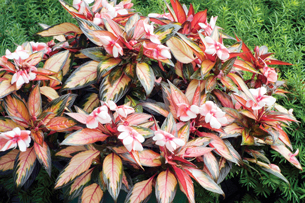
© Joe Kucharski/shutterstock
Alberta is rich in arable farmland capable of producing food far beyond the needs of Albertans. Large amounts of wheat, barley, and oil seeds (canola) are exported to Mexico, the United States, China, Japan, and other Pacific Rim countries.
While Albertans depend on the productivity of agricultural plants for food, energy, and oxygen, there is also an economic benefit tied to the process of photosynthesis. The biosphere depends on photosynthesis to cycle carbon and oxygen and throughout many parts of the world, people depend on Alberta crops for food.
Are all plants the same? Some plants grow better in the shade; while other plants do best in bright, sunny locations. Plants in Alberta's prairies look very different from plants in Banff National Park. Some plants are better suited to become crop or orchard plants. Could this have something to do with photosynthesis?
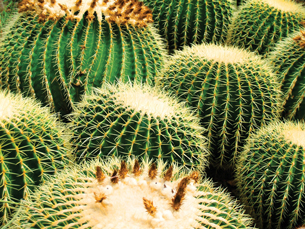
© cardiae/shutterstock
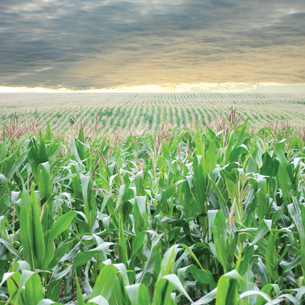
© mike_expert/shutterstock
In this lesson the following essential questions will be examined:
- What factors affect photosynthesis?
- What technologies have emerged from photosynthesis-based research?
 Module 5: Lesson 4 Assignment
Module 5: Lesson 4 Assignment
Your teacher marked Module 5: Lesson 4 Assignment requires you to submit a response to the following:
- TR 1. Types of Photosynthesis
- TR 2. Technology and Photosynthesis
You can access your Module 5: Lesson 4 Assignment. You can print off the assignment or save the download to your computer. Your answers can be saved on this document to your course folder.
You must decide what to do with the questions that are not marked by the teacher.
Remember that these questions provide you with the practice and feedback that you need to successfully complete this course. You should respond to all the questions and place those answers in your course folder.
1.20. Page 2
Module 5—Photosynthesis and Cellular Respiration
 Explore
Explore
 Read
Read
You have already investigated factors affecting photosynthesis in Module 1: Lesson 1 of Biology 20. At the beginning of this course, you used a virtual lab to study photosynthesis under a variety of conditions. Your assignment asked you to make conclusions about the effect of light intensity, carbon dioxide, temperature, and light wavelength on the production of oxygen. You may want to review your Lesson 1 Assignment and the Photosynthesis Gizmo.
In Module 1 you also looked at biogeochemical cycles. Photosynthesis is critical in the cycling of oxygen and carbon dioxide. You now have a better idea of how oxygen and carbon are cycled by light-dependent and light-independent reactions.
The following two diagrams from Lessons 2 and 3 of Module 5 review the stages of photosynthesis.


By looking at the process of photosynthesis as a series of reactions, you can now see exactly where the factors affecting photosynthesis have their effect. Answer the following Self-Check questions.
 Self-Check
Self-Check
SC 1. Complete this Self-Check activity.
1.21. Page 3
Module 5—Photosynthesis and Cellular Respiration
 Read
Read
Plant Productivity and Types of Photosynthesis
In Module 2: Lesson 1 you were introduced to productivity. Plant productivity can be related to biomass. Biomass is produced by photosynthesis and is measured in units of dry organic matter (kg/m2/ yr). The higher the biomass, the greater the productivity. When farmers talk about crop yields, they are hoping for high levels of plant productivity. Plant productivity is directly related to the metabolic process of photosynthesis.
The ability for farms and orchards to produce large amounts of food is of great importance to people. In 2008, it was reported that there may be a global food-shortage crisis. There is not enough food, such as wheat and corn, being stored or grown to support both human consumption and biofuel production. Booming populations and a switch to meat-rich diets in the developing world have increased the demand for wheat and rice.
How can photosynthesis-related technologies help this potential crisis?
 Try This
Try This
TR 1. Types of Photosynthesis
Ninety-five percent of plants follow the Calvin-Benson cycle that you examined in Lesson 3. These plants form 3-carbon molecules of PGAL, which are then used to make glucose. Scientists refer to these plants as C3 plants. A birch tree is an example of this type of plant.
In climates with intense sunlight and high temperatures, C3 plants are not very efficient. Gas exchange in the leaves of plants is controlled by the stomata. In warmer temperatures, plant leaves must keep their stomata closed to reduce water loss. Closing the stomata prevents carbon dioxide from being absorbed into cells for use during photosynthesis. In addition, the buildup of oxygen as a waste gas in leaves inhibits carbon fixation.
Plants in these conditions may open their stomata at night to release waste oxygen and store carbon dioxide. In hot, dry conditions, plants with other mechanisms to convert carbon dioxide into glucose are more efficient. These plants, such as C4 and CAM plants, have evolved by adapting to their environmental conditions.
How have scientists applied their knowledge of the different types of photosynthesis to plant productivity (agricultural technologies)?
Use the Internet or print resources, such as your textbook, to research C3, C4, and CAM plants. You will be placing your findings in a chart found in your Module 5: Lesson 4 Assignment. Be sure to save your information to your course folder.
 Self-Check
Self-Check
SC 2. Complete this phrase: Productivity and sustainability are influenced by______________. Perform a web search with the keywords “sustainability plant productivity grasslands.”
 Self-Check Answer
Self-Check Answer
SC 2. Productivity and sustainability are influenced by biodiversity.
Studies suggest that species richness, in producers and consumers, maintains a sustainable environment. Jot down some of your ideas about the effect of biodiversity on plant productivity and photosynthesis. Save your ideas in your course folder. It is beneficial to review past topics and apply them to new information.
 Watch and Listen
Watch and Listen
In Module 2: Reflect on the Big Picture, you were asked to create a list of technologies related to photosynthesis. You may have explored biofuels, agriculture, greenhouse gas reduction, and hydrogen gas production. But you may not have considered herbicides as a technology related to photosynthesis. Watch the video of the time-lapsed effects of herbicides on a plant. Since many herbicides interfere with the process of photosynthesis, they are considered to be metabolic toxins. You will be taking a closer look at metabolic toxins in Lesson 7.
Kelly Goedde, Tom Bauman, Case Medlin, Glenn Nice, Bill Johnson, Purdue University
1.22. Page 4
Module 5—Photosynthesis and Cellular Respiration
 Reflect and Connect
Reflect and Connect
Agriculture is one area where photosynthesis research has been applied. Knowing which plants are more efficient at carbon fixation and, therefore, are more efficient at producing biomass is critical knowledge when planning for crops. It also leads researchers to try and manipulate the process of photosynthesis to create even better efficiency. Researchers take into account such factors as temperature that affect photosynthesis when they conduct investigations.
 Reflect on the Big Picture
Reflect on the Big Picture
Without an intricate knowledge of photosynthesis, scientists would be unable to produce technology to benefit humans. As populations explode and vegetation is lost, it becomes apparent that people may come to rely on the efforts of scientists to exploit the process of photosynthesis in order for people experience a sustainable future.
 Try This
Try This
TR 2. Technology and Photosynthesis
This is your chance to do a bit more research on photosynthesis. You may have already discovered some interesting technologies related to photosynthesis. In this activity you will determine
- what part of photosynthesis is affected or enhanced by the technology
- how the technology benefits humans
- the current use of the technology or research
Choose one of the following technologies to research:
- hydrogen gas production
- biofuels
- sustainable agriculture
- herbicides
You may present your research in essay form, point form, through an illustration, or a slide show. You will find a marking rubric and room for your response in your Lesson 4 Assignment.
 Going Beyond
Going Beyond
What role does biodiversity play in plant productivity and photosynthesis? You may want to do some research for this question.
 Module 5: Lesson 4 Assignment
Module 5: Lesson 4 Assignment
Remember to submit the Assignment answers to your teacher as part of your Module 5: Lesson 4 Assignment.
1.23. Page 5
Module 5—Photosynthesis and Cellular Respiration
 Lesson Summary
Lesson Summary
In this lesson the following essential questions were explored:
- What factors affect photosynthesis?
- What technologies have emerged from photosynthesis-based research?
You revisited factors affecting photosynthesis, such as carbon-dioxide levels, light intensity, light wavelength, and temperature. These topics were originally explored in Module 1.
Photosynthesis-based research has determined that there are three types of photosynthesis. Most plants, however, perform photosynthesis as described in Lesson 3 of this module.
Some plants have evolved to be more efficient at carbon fixation as a result of their environmental conditions. Scientists have capitalized on this knowledge by applying it to agriculture.
You also explored other technologies that may help achieve future global sustainability.
Lesson Glossary
CAM: crassulacean acid metabolism (CAM photosynthesis); an elaborate carbon fixation pathway in some plants
1.24. Lesson 5 Intro
Module 5—Photosynthesis and Cellular Respiration
Lesson 5—Anaerobic Respiration
 Get Focused
Get Focused
Fart is a funny word. In fact, farts sound funny and smell funny too. Has it ever occurred to you that there is a good reason why people fart? Indeed. The good reason involves the idea that all cells do not always require oxygen. Cells are able to function without oxygen and gain the energy they need from organic compounds.
The production of gases and acids through anaerobic respiration has been pursued by industry in many different ways. The food industry uses anaerobic respiration in bread and cheese production, while the wine industry depends on this type of respiration to create its product. How does a knowledge of anaerobic respiration further the growth of different technologies?
In this lesson you will explore the following essential questions:
- How far can cellular respiration go without the presence of oxygen?
- How does anaerobic respiration release potential energy from organic compounds?
 Module 5: Lesson 5 Assignment
Module 5: Lesson 5 Assignment
Your teacher-marked Module 5: Lesson 5 Assignment requires you to submit a response to the following:
- TR 1. Anaerobic Respiration → Fermentation
You can access your Module 5: Lesson 5 Assignment. You can print off the assignment or save the download to your computer. Your answers can be saved on this document to your course folder.
You must decide what to do with the questions that are not marked by the teacher.
Remember that these questions provide you with the practice and feedback that you need to successfully complete this course. You should respond to all the questions and place those answers in your course folder.
1.25. Page 2
Module 5—Photosynthesis and Cellular Respiration
 Explore
Explore
 Read
Read
Anaerobic respiration occurs when oxygen is not present. When oxygen isn’t present, common anaerobic respiration by-products are sulfur, nitrite, methane, and odourless carbon dioxide. The colon contains bacteria that function without oxygen. By-products of this respiration in people are smelly gases. You will explore anaerobic respiration further as you move through this lesson.
Consider the following diagram.

glycolysis: a metabolic pathway in which one glucose molecule is broken down to form two, 3-carbon molecules and a small amount of ATP
Glycolysis is the first step in both anaerobic and aerobic respiration.
pyruvate: three-carbon molecules produced by glycolysis
phosphorylation: the process of adding a phosphate to a molecule; occurs in cellular respiration and photosynthesis
You consume many complex sugars, like lactose (dairy products) and fructose (fruit), which your body breaks down to glucose that can be used at the cellular level.
All cellular respiration begins with glycolysis. Glycolysis occurs in the cytoplasm. It starts with a 6-carbon glucose molecule and consists of a series of oxidation reduction reactions that essentially split glucose into two, 3-carbon molecules called pyruvate. Pyruvate is then transported into the mitochondria for further processing and energy harvesting or remains available in the cytoplasm for the process of fermentation.
What energy gains are made during glycolysis? Early in glycolysis, two ATP molecules are used to energize glucose to split in two. Glucose is oxidized.
Later, four molecules of ADP undergo phosphorylation to produce four molecules of ATP.
Electrons are donated to two molecules of NAD+ to generate two molecules of NADH. In glycolysis, there is a net energy yield of 2 ATP and 2 NADH molecules.

If you need a further explanation of the glycolysis process, read “Outside the Mitochondria: Glycolysis” on pages 183 and 186 of the textbook.
 Watch and Listen
Watch and Listen
The “How Glycolysis Works” animation shows how NADH, ATP, and pyruvate are produced during glycolysis.
 Self-Check
Self-Check
SC 1. Where does glycolysis occur?
SC 2. Does glycolysis occur without oxygen?
SC 3. What are three products of glycolysis?
 Self-Check Answers
Self-Check Answers
SC 1. Glycolysis occurs in the cytoplasm.
SC 2. Glycolysis occurs without oxygen.
SC 3. ATP, NADH, and pyruvate are products of glycolysis.
1.26. Page 3
Module 5—Photosynthesis and Cellular Respiration
 Read
Read

© Shawn Pecor/shutterstock
At the end of glycolysis, three things can happen:
- Aerobic Respiration – If oxygen is present, pyruvate is transported to the matrix of the mitochondria where it becomes a part of the Krebs cycle. You will look at this in Lesson 6.
- Lactate Fermentation – If single-celled organisms, plant, or animal cells (like yeast, root cells, or muscle cells) are temporarily without oxygen lactate fermentation occurs. These cells experience an oxygen debt that can be reversed. The products of glycolysis have exceeded the oxygen supply. Pyruvate molecules build up faster than they can be used. For example, during a strenuous workout your muscle cells will convert pyruvate to lactic acid (lactate) by oxidizing NADH. NAD+ returns to be used again in glycolysis. This buildup of lactate can cause muscle cramps and fatigue. When oxygen is reintroduced (heavy breathing after a workout), lactate reforms pyruvate, which moves to the mitochondria to take part in aerobic respiration.
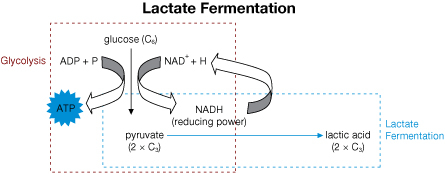
- Ethanol Fermentation – If oxygen is not present and not required, organisms function anaerobically. These organisms, like yeast and bacteria, convert pyruvate to ethanol and CO2(g) by oxidizing NADH. NAD+ returns to be used again in glycolysis.
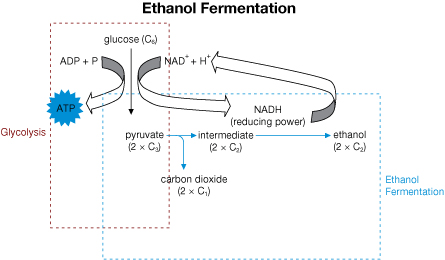
Anaerobic respiration does not completely break down glucose and yields only two ATP molecules for every glucose molecule. Multicellular organisms, including humans, can only operate in oxygen-free conditions for a limited amount of time. Not enough energy is created in anaerobic respiration for multicellular organisms to carry out metabolic processes. Organisms that only rely on anaerobic respiration are typically unicellular (bacteria and yeasts).
 Watch and Listen
Watch and Listen
You may find that the readings on pages 190 and 191 of the textbook will help you understand the concepts you just learned about. The readings may also help you understand the animation Lactate and Alcohol Fermentation. This animation shows the redox reactions that occur during fermentation by indicating the role of NADH, ATP, and pyruvate.
 Self-Check
Self-Check
SC 4. Carbon dioxide is a product of __________.
SC 5. What kinds of cells carry out anaerobic respiration?
SC 6. What is the ATP output of anaerobic respiration?
 Self-Check Answers
Self-Check Answers
SC 4. Carbon dioxide is a product of alcohol/ethanol fermentation.
SC 5. Cells that carry out anaerobic respiration include the following: single- celled organisms like yeast and bacteria; plant cells submerged in water; cells deep within a multicellular organism without direct access to oxygen; and cells temporarily lacking oxygen (muscle cells).
SC 6. Anaerobic respiration yields two ATP molecules for every oxidized glucose molecule.
SC 7. You will match molecules with a statement in this exercise.
 Try This
Try This
TR 1. Anaerobic Respiration → Fermentation
Now that you have explored anaerobic respiration, it is time to see how well you understand and can explain the process of respiration under anoxic conditions. Go to your Lesson 5 Assignment and complete the Try This questions.
 Read
Read
biofuel: ethanol produced during the fermentation of biomass
biogas: methane captured from animal waste that is used as fuel
Fermentation is used to produce a number of commercial products, such as cheese, breads, and beer. Different strains of bacteria produce unique fermentation products as a result of the genes they express and are, therefore, used to produce specific commercial products. Some examples are listed in the following table.
Commercial Product |
Fermentation Product |
Type of Organism Involved |
yogurt and some cheeses |
lactate (lactic acid) |
bacteria |
vinegar, ketchup, mayonnaise |
ethanoic acid (acetic acid) |
bacteria |
buttermilk |
2, 3-butanedione |
bacteria |
Swiss cheese |
propanoic acid and carbon dioxide |
bacteria |
biogas |
methane |
bacteria |
beer, wine, spirits, and biofuel |
ethanol |
yeast and some bacteria |
bread |
carbon dioxide |
yeast |
Two particularily interesting products because of their potential to replace fossil fuels are biogas and biofuels. To learn more about the uses of biofuel and biogas, read "Ethanol Fermentation and Fuel Production" and "Ethanol Production" on pages 191 and 193 of the textbook. Also read “Energy from Manure” on page 192.
1.27. Page 4
Module 5—Photosynthesis and Cellular Respiration
 Reflect and Connect
Reflect and Connect
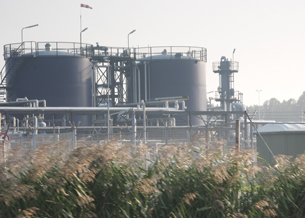
© André Klaassen/shutterstock
Technology has advanced in the areas of biofuel and biogas. Without an understanding of anaerobic respiration, these technologies that benefit society would not exist. The products of anaerobic respiration would still be produced, but not used for the benefit of humans.
Use the Internet to research biofuel and biogas development in Canada. Compile a report detailing the similarities and differences between these substances. Charts can be a good way of comparing and contrasting. Since you are gathering and collecting information from a variety of sources, make certain to use your own words and identify the references you have used. You may present your report as a written document or as a slide show.
Be sure to include the following information:
- Identify the raw material used to make biofuel and biogas. Identify alternative raw materials that can also be used to produce the same product.
- Create a graphic that lists the steps used to produce biofuel and biogas. You can use diagrams from the Internet for ideas, and you can use clipart to help with diagrams, but do not copy flow charts off the Internet.
- List possible uses for biofuel and biogas.
- Write the chemical formulas for biofuel and biogas. Explain the statement that biofuel and biogas still represent energy-rich compounds. Compare the chemical composition of each substance to carbon dioxide, which is the product of the complete oxidation of glucose.
- What are some of the problems associated with the processes used to produce each of these substances?
You can find this activity and the marking rubric in your Assignment.
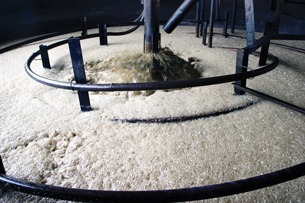
© Americo MARIANO/iStockphoto
 Reflect on the Big Picture
Reflect on the Big Picture
How has matter and energy been transferred through anaerobic respiration? Anaerobic respiration is linked to the carbon cycle. Glucose is used to generate ATP—the energy currency for the cell. ATP is required for all cells to perform metabolic functions that build, repair, digest, and create movement. A carbon- based gas or acid is a by-product of the oxidization of glucose.
The food, wine, and fuel industries have capitalized on the products created through anaerobic respiration. The need to explore alternative energy/fuel sources may encourage further development of respiration-related technologies.
 Module 5: Lesson 5 Assignment
Module 5: Lesson 5 Assignment
Remember to submit the Assignment answers to your teacher as part of your Module 5: Lesson 5 Assignment.
1.28. Page 5
Module 5—Photosynthesis and Cellular Respiration
 Lesson Summary
Lesson Summary
In this lesson you explored the following essential questions:
- How far can cellular respiration go without the presence of oxygen?
- How does anaerobic respiration release potential energy from organic compounds?
Principles of anaerobic respiration have been utilized by industry to create food and fuels. Scientists have learned the value of single-celled organisms to the production of foods like bread and yogurt and fuels such as biogas. In order for this technology to provide people with the mass-produced food and fuels that exist today, researchers need a solid understanding of the chemical reactions that occur to transfer energy and matter among cells.
As you worked through this module, you discovered that the initial step of all respiration begins with glycolysis. Oxygen is not required for gylcolysis to occur. When oxygen is not available to normally aerobic cells, the process of lactate fermentation occurs. Glucose becomes oxidized and forms pyruvate and ATP.
Pyruvate is reduced by NADH to form lactic acid. It is a lactic acid buildup that causes muscles to become sore during strenuous exercise. Fortunately, the production of lactic acid is reversible once an oxygen debt is repaid.
Many cells, such as bacteria and yeast, do not require oxygen to survive so they function through the process of alcohol fermentation. When you leave a lunch container sealed in your bag for a few weeks, this type of fermentation occurs. Glycolysis breaks down glucose, provides energy for the cells to do work, and produces ethanol and carbon dioxide. The container may bulge with the production of the gas, and you will come to know what fermentation smells like!
Both lactate fermentation and alcohol fermentation produce two ATP molecules from the oxidation of glucose. As you explore aerobic respiration, you will discover that aerobic respiration is more efficient at producing ATP from the breakdown of glucose molecules.
Lesson Glossary
biofuel: ethanol produced during the fermentation of biomass
biogas: methane captured from animal waste that is used as fuel
glycolysis: a metabolic pathway in which one glucose molecule is broken down to form two, 3-carbon molecules and a small amount of ATP
Glycolysis is the first step in both anaerobic and aerobic respiration.
phosphorylation: the process of adding a phosphate to a molecule; occurs in cellular respiration and photosynthesis
pyruvate: three carbon molecules produced by glycolysis
1.29. Lesson 6 Intro
Module 5—Photosynthesis and Cellular Respiration
Lesson 6—Aerobic Respiration
 Get Focused
Get Focused
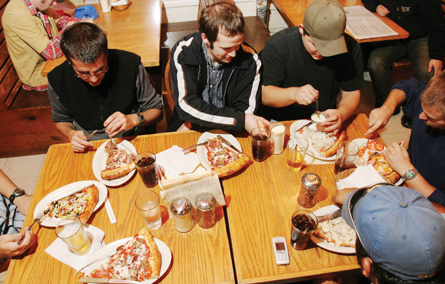
© Kevin Russ/iStockphoto
In Unit A you explored how the energy people get from food starts with solar energy. You should also understand that solar energy is stored as glucose through the process of photosynthesis. Plants do not produce starches and sugars just to feed animals—they use the compounds they produce for their own energy needs, such as growth, repair, and the completion of chemical reactions involved in other cellular processes.
However, plants do provide the energy and oxygen humans and other organisms need by storing complex carbohydrates and producing oxygen. The following chart shows some of the uses of energy.
|
Use of Energy |
Explanation |
Voluntary Actions |
Motion |
Organisms need energy to make their muscles contract. This allows them to walk, fight, make noise, and run. |
| Involuntary Actions | Breathing |
Organisms need energy to contract muscles in and around their lungs to breathe. |
Thinking |
Organisms need energy to activate nerve cells in their brains. |
|
Growth |
Organisms use energy to make enzymes and to activate chemical reactions that build new cells. These new cells will result in growth. |
|
Repair |
Organisms use energy to repair or replace cells that are damaged. |
|
Active Transport |
Organisms need energy to transport materials throughout their cells and bodies. |
Before riding a bike or being active in some other way, do you think about how the carbohydrates/sugars you consume and the oxygen that you breathe become part of the energy pathway that supports your activity?
In this lesson the following essential questions will be explored:
- How does the presence of oxygen affect cellular respiration?
- How does aerobic cellular respiration release potential energy from organic compounds?
 Module 5: Lesson 6 Assignment
Module 5: Lesson 6 Assignment
Your teacher-marked Module 5: Lesson 6 Assignment requires you to submit a response to the following:
- TR 1. Comparing Chemiosmosis in Photosynthesis and Cellular Respiration
- TR 2. Estimate Your VO2 Max
You can access your Module 5: Lesson 6 Assignment. You can print off the assignment or save the download to your computer. Your answers can be saved on this document to your course folder.
You must decide what to do with the questions that are not marked by the teacher.
Remember that these questions provide you with the practice and feedback that you need to successfully complete this course. You should respond to all the questions and place those answers in your course folder.
1.30. Page 2
Module 5—Photosynthesis and Cellular Respiration
 Explore
Explore
 Read
Read
Krebs cycle: a metabolic pathway consisting of a series of reactions that break down the end products of glycolysis, producing carbon dioxide and generating a large amount of ATP; also know as the citric acid cycle; named after the 1953 Nobel Prize winning scientist who made the discovery
As you explored in Lesson 5, glycolysis is the first step in cellular respiration. Glycolysis is anaerobic, but cellular respiration can continue aerobically. Under oxygenated conditions, cellular respiration moves from the cytoplasm of the cell to the matrix of the mitochondria. The products of glycolysis—pyruvate and NADH—move into the matrix where they become a part of the Krebs cycle.
Aerobic respiration can be summarized by this familiar statement:
![]()
You will be exploring what happens inside the mitochondria to produce ATP, CO2(g) and H2O(l).
Before you continue with this lesson, it will be useful to read “Inside the Mitochondria: Krebs Cycle Preparation” and “The Krebs Cycle” on pages 187 and 188 of the textbook.
 Self-Check
Self-Check
SC 1. Complete this Self-Check activity.
 Read
Read
First, have a look at the simplified steps of aerobic respiration involving one molecule of glucose.
- Glycolysis:
- The first step breaks down glucose into pyruvate.

-
acetyl CoA: an oxidized form of glucoseIn the intermediate step, pyruvate is converted to acetyl CoA.
- Reduced NADH is produced as well as CO2(g).
NADH: a high-energy electron carrier
It acts as an electron donor to the electron transport system involved in the production of ATP.
FADH2: an important coenzyme produced during Krebs cycle
It acts as an electron donor to the electron transport system involved in the production of ATP.
- Krebs Cycle:
- acetyl CoA provides electrons for the electron transport chain.
-
acetyl CoA is oxidized to produce reduced NADH and FADH2.
-
acetyl CoA is oxidized to produce reduced NADH and FADH2.
- CO2(g) is produced.
- ATP is produced.

- Electron transport chain:
- Uses the electrons from NADH and FADH2 to make a lot of ATP
- The oxidation of NADH and FADH2 create a proton gradient that powers ATP synthase (chemiosmosis is similar to photosynthesis).
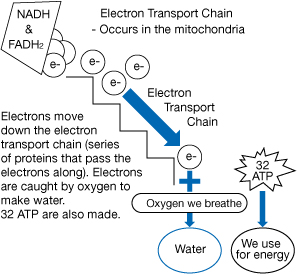
- The oxidation of NADH and FADH2 create a proton gradient that powers ATP synthase (chemiosmosis is similar to photosynthesis).
 Self-Check
Self-Check
SC 2. What compound derived from glucose actually enters the Krebs cycle?
SC 3. The carbon atoms derived from glucose are fully oxidized in the Krebs cycle. What becomes reduced during the Krebs cycle? (Remember: LEO the lion goes GER)
 Self-Check Answers
Self-Check Answers
SC 2. Acetyl CoA enters the Krebs cycle.
SC 3. NAD+ is reduced to NADH, and FAD is reduced to FADH2.
 Read
Read
How much energy does one glucose molecule provide when oxygen is the final electron acceptor?
ATP Totals for Aerobic Respiration
Glycolysis 2 ATP
Krebs Cycle 2 ATP
Electron Transport Chain 32 ATP
36 ATP from 1 glucose
You have determined that the electron transport chain creates most of the energy for cellular respiration. So, what is the purpose of the Krebs cycle?
 Watch and Listen
Watch and Listen
 Self-Check
Self-Check
SC 4. What is the purpose of the Krebs cycle?
SC 5. How does the word catabolism apply to the Krebs cycle?
 Self-Check Answers
Self-Check Answers
SC 4. The purpose of the Krebs cycle is to fully oxidize glucose, provide electrons for the electron transport chain, and create some usable energy for the cell.
SC 5. Catabolism means to break down molecules into smaller components and release energy. The Krebs cycle breaks down glucose through oxidation and ATP is synthesized.
1.31. Page 3
Module 5—Photosynthesis and Cellular Respiration
 Read
Read
How does looking at the steps involved in aerobic respiration relate to people getting energy to move around? You have followed the path of glucose through glycolysis and the Krebs cycle. You have been shown that an electron transport system is where the majority of ATP is synthesized during aerobic respiration. Oxygen is involved in the electron transport system as a final electron acceptor.
The series of reactions involved in aerobic respiration produce large amounts of ATP from just one glucose molecule. As a result, you have energy for activities that you chose and involuntary activity that your body does on its own.
 Watch and Listen
Watch and Listen
This animation will show the final step involved in the synthesis of ATP.
![]() Try This
Try This
TR 1. Comparing Chemiosmosis in Photosynthesis and Cellular Respiration
Chemiosmosis, the movement of hydrogen ions to make ATP, was introduced in Lesson 3 as you learned about photosynthesis. Prepare a list of three similarities and three differences between chemiosmosis in photosynthesis and chemiosmosis in cellular respiration. Your list may include diagrams to illustrate. You may choose to create a slideshow presentation or a podcast of your list. Indicate in the space provided where your teacher may access this activity if it cannot be directly put into this document. Be sure to save your work to your course folder.
Answer this activity in your Lesson 6 Assignment.
 Read
Read
VO2 Max
How have athletes capitalized on understanding the process of cellular respiration?
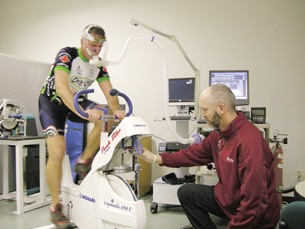
Athletic training programs are designed to increase the body’s ability to deliver and utilize oxygen to become more efficient in the production of ATP. As you saw in Lesson 5, higher levels of physical activity can cause the accumulation of lactate when pyruvate—produced by glycolysis—is not able to be oxidized by the Krebs cycle. The point at which an athlete begins to accumulate lactate in muscle tissues can be used as an indicator of fitness. And this point can also be utilized as a tool for planning further training to improve performance.
Athletes and coaches use a test called VO2 max (the volume of oxygen used at maximal exertion) to determine how well an athlete is able to use oxygen. The test, as shown, is most often conducted in a sports-medicine laboratory because it requires specialized equipment. Although the noted test occurs on a stationary bicycle, the test can also be performed on a running treadmill or on a rowing machine. It is also possible for athletes without the ability to use their legs to do the test by using an arm ergometer or a treadmill adapted for a wheelchair.
During the test, the athlete exercises to exhaustion while the heart rate and chemical composition of inhaled and exhaled air are analyzed. Measuring the quantity of oxygen used by the athlete requires that participants wear a mask to allow inhaled and exhaled gases to be analyzed for their concentrations of oxygen and carbon dioxide. The values for VO2 max are expressed as millilitres of oxygen used per kilogram of body mass per minute of activity (mL/kg/min). This technology—based on cellular respiration—helps athletes train and achieve higher levels of fitness.
 Try This
Try This
TR 2. Estimate Your VO2 Max
Caution
If you have a medical condition that prevents you from participating in physical education classes, you should not participate in the exercising part of this activity.
Although a VO2 measurement requires sophisticated equipment, there are a number of methods that you can use to estimate your VO2 max.
In order to estimate your VO2 max, you can perform some sort of physical activity. A simple way to do this is to perform a step test.
To start this test you will require
- a bench or step 12 inches high
- a stopwatch
- a heart-rate monitor (optional)
To conduct this test, you will
- step up and down, one foot at a time, onto the step or bench for 3 minutes
- try to maintain a steady four-beat cycle (approximately 22 to 24 steps/minute)
- use music or counting to help you keep to the required pace
- count your number of heart beats for 15 seconds when you finish the test
- multiply the number of beats in 15 seconds by 4
- repeat this 2 more times
To calculate your VO2 max, you will have to do a websearch using the keywords “VO2 max uk.”
Once you are on a VO2 max website, scroll down to the list of VO2 max tests. Choose a VO2 max step test. Scroll down the page to the Performance Assessment section. Enter your gender and pulse rate. Click on the Calculate button. How well does your body consume oxygen? Use the chart that follows to determine your fitness.
You may also use the “VO2 max from non-exercise data” test.
Female (values in ml/kg/min)
Age |
Very Poor |
Poor |
Fair |
Good |
Excellent |
Superior |
13-19 |
<25.0 |
25.0 - 30.9 |
31.0 - 34.9 |
35.0 - 38.9 |
39.0 - 41.9 |
>41.9 |
20-29 |
<23.6 |
23.6 - 28.9 |
29.0 - 32.9 |
33.0 - 36.9 |
37.0 - 41.0 |
>41.0 |
30-39 |
<22.8 |
22.8 - 26.9 |
27.0 - 31.4 |
31.5 - 35.6 |
35.7 - 40.0 |
>40.0 |
40-49 |
<21.0 |
21.0 - 24.4 |
24.5 - 28.9 |
29.0 - 32.8 |
32.9 - 36.9 |
>36.9 |
50-59 |
<20.2 |
20.2 - 22.7 |
22.8 - 26.9 |
27.0 - 31.4 |
31.5 - 35.7 |
>35.7 |
60+ |
<17.5 |
17.5 - 20.1 |
20.2 - 24.4 |
24.5 - 30.2 |
30.3 - 31.4 |
>31.4 |
Male (values in ml/kg/min)
Age |
Very Poor |
Poor |
Fair |
Good |
Excellent |
Superior |
13-19 |
<35.0 |
35.0 - 38.3 |
38.4 - 45.1 |
45.2 - 50.9 |
51.0 - 55.9 |
>55.9 |
20-29 |
<33.0 |
33.0 - 36.4 |
36.5 - 42.4 |
42.5 - 46.4 |
46.5 - 52.4 |
>52.4 |
30-39 |
<31.5 |
31.5 - 35.4 |
35.5 - 40.9 |
41.0 - 44.9 |
45.0 - 49.4 |
>49.4 |
40-49 |
<30.2 |
30.2 - 33.5 |
33.6 - 38.9 |
39.0 - 43.7 |
43.8 - 48.0 |
>48.0 |
50-59 |
<26.1 |
26.1 - 30.9 |
31.0 - 35.7 |
35.8 - 40.9 |
41.0 - 45.3 |
>45.3 |
60+ |
<20.5 |
20.5 - 26.0 |
26.1 - 32.2 |
32.3 - 36.4 |
36.5 - 44.2 |
>44.2 |
Once you have determined your VO2 max level, consider the following questions before you access your Assignment.
- Were the calculated estimates consistent?
- Suggest reasons why there might be differences between the estimates.
- Were you able to complete the test and, if so, what effect might that have on the value obtained?
- How do you think your value would compare with a VO2 max test performed in a laboratory?
- How does this relate to cellular respiration?
- What does it mean, in terms of aerobic respiration, if your VO2 max value is high?
- What is the relationship between heart rate and cellular respiration?
You will answer similar questions in your Lesson 6 Assignment.
 Discuss
Discuss
How did you do in the VO2 max test? Post reasons why you believe you achieved the score that was estimated and how valuable this kind of test can be. You do not have to post your actual score. See what your peers have to say about their tests.
1.32. Page 4
Module 5—Photosynthesis and Cellular Respiration
 Reflect and Connect
Reflect and Connect
The purpose of aerobic respiration is to provide organisms with energy to complete voluntary and involuntary tasks. This energy ultimately comes from glucose created in photosynthesis. Glucose can become a part of other molecules like fats and proteins, but before those molecules hit the Krebs cycle they have been catabolized. ATP synthesized in the electron transport chain is available to cells. Cells can then perform functions that help people move about (muscle contractions) and keep them alive (nerve transmission). Energy is derived from the organic compound glucose.
 Self-Check
Self-Check
SC 6. Complete this Self-Check Activity.
 Reflect on the Big Picture
Reflect on the Big Picture
Can you make connections between photosynthesis and cellular respiration?
Complete the following activity and save it to your course folder. It will become an essential review tool. If you would like feedback, contact your instructor.
 Going Beyond
Going Beyond
If you would like to understand more about the role of enzymes in oxidation-reduction reactions, watch the following animation “How the NAD+ Works”
1.33. Page 5
Module 5—Photosynthesis and Cellular Respiration
 Lesson Summary
Lesson Summary
In this lesson the following essential questions were explored:
- How does the presence of oxygen affect cellular respiration?
- How does aerobic cellular respiration release potential energy from organic compounds?
You are already familiar from previous lessons and science courses that oxygen is required in aerobic respiration. In this lesson you discovered that the specific role of oxygen is to be a final electron acceptor in the electron transport chain. This chain is located in the inner membrane of the mitochondrial matrix. Oxygen accepts electrons from oxidized glucose and combines with hydrogen molecules to produce water. When oxygen is present, 36 molecules of ATP are produced compared to 2 molecules of ATP during anaerobic respiration.
The production of ATP occurs through a series of metabolic pathways. In each step of aerobic respiration glucose (or an intermediate carbon molecule) is oxidized and ATP is synthesized through phosphorylation. For every glucose that is completely oxidized, glycolysis produces 2 ATP, the Krebs cycle produces 2 ATP, and the electron transport chain synthesizes the jackpot of 32 ATP molecules. Cells will use the energy to fuel activities such as active transport, muscle contraction, and biochemical synthesis. Since multicellular organisms have high energy demands, it makes sense that these organisms function aerobically.
Lesson Glossary
acetyl CoA: an oxidized form of glucose
FADH2: an important coenzyme produced during Krebs cycle
It acts as an electron donor to the electron transport system involved in the production of ATP.
Krebs cycle: a metabolic pathway consisting of a series of reactions that break down the end products of glycolysis, producing carbon dioxide and generating a large amount of ATP; also know as the citric acid cycle; named after the 1953 Nobel Prize winning scientist who made the discovery
NADH: a high-energy electron carrier
It acts as an electron donor to the electron transport system involved in the production of ATP.
VO2 max: used to measure how well an athlete is able to use oxygen during an activity: units are mL/kg/min
1.34. Lesson 7 Intro
Module 5—Photosynthesis and Cellular Respiration
Lesson 7—Investigating Cellular Respiration
 Get Focused
Get Focused
Cellular respiration—everything’s doing it! If you think about it, cellular respiration is the most-performed function by living organisms. All domains of organisms depend on cellular respiration to fuel life processes. Scientists know that understanding this important process is key to the advancement of many types of technology. Included technologies are in the food and agricultural industry and in medical research.
As you do some research, can you see how understanding cellular respiration is important to science, society, and technology?
In this lesson the following essential questions will be explored:
- How can you demonstrate quantitatively that germinating seeds consume oxygen?
- How do metabolic toxins affect cellular respiration?
 Module 5: Lesson 7 Assignment
Module 5: Lesson 7 Assignment
Your teacher-marked Module 5: Lesson 7 Assignment requires you to submit a response to the following:
- LAB: Oxygen Consumption and Heat Production in Germinating Seeds
- TR 1. The Effects of Metabolic Toxins on Cellular Respiration
You can access your Module 5: Lesson 7 Assignment. You can print off the assignment or save the download to your computer. Your answers can be saved on this document to your course folder.
You must decide what to do with the questions that are not marked by the teacher.
Remember that these questions provide you with the practice and feedback that you need to successfully complete this course. You should respond to all the questions and place those answers in your course folder.
1.35. Page 2
Module 5—Photosynthesis and Cellular Respiration
 Explore
Explore
 Read
Read
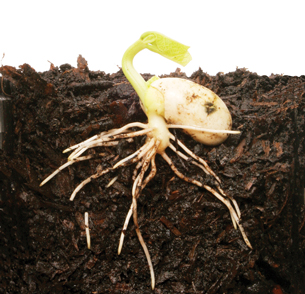
© Richard Griffin/shutterstock
The germination of seeds is an example of a plant process that requires energy and oxygen. When you think of plants, you generally think about photosynthesis. But plants need energy to grow as well. When a seed germinates, it uses stored energy present within the seed to support the growth of the seedling.
During germination, cellular respiration converts energy from the carbohydrate within the seed into a form usable by the seedling cells. The chemical potential energy available from the starch and other sugars within most seeds is converted into glucose and then into ATP by the process of cellular respiration.
While cellular respiration breaks chemical bonds to release energy to produce ATP, the process also releases 64% of its energy as heat. In the following lab you will be asked to interpret collected data as evidence of oxygen consumption and heat production in germinating seeds. Research such as this opens avenues of further research which can benefit humans.
1.36. Lab
Module 5—Photosynthesis and Cellular Respiration
LAB: Oxygen Consumption and Heat Production in Germinating Seeds
Investigate the energy required during the germination of seeds by completing the lab “Oxygen Consumption and Heat Production in Germinating Seeds.” You will be completing this lab as outlined in your textbook on pages 184 and 185. You may choose to do “Part 1: Oxygen In Cellular Respiration” by using the virtual lab.
“Part 2: Heat Production in Cellular Respiration” will be completed as described in the textbook. You may decide to work in a group to complete Part 2. In this part of your investigation you will create an experimental plan that demonstrates that heat is a product of germinating seeds. If you are unable to carry out your experimental design, data will be provided for your interpretation in your Assignment.
You will also be asked to provide hypotheses for Part 1 and Part 2. Click on the tab below to give you a clear idea of how to prepare your hypotheses.
How to Write a Hypothesis
A good hypothesis helps a researcher limit an investigation to the effect of one variable at a time. This allows a clear interpretation of observations. To develop a good hypothesis, you need to establish the variables that you are studying and make a prediction on how those variables interact. At this stage in your scientific career, it is best to create a simple hypothesis. The process to form a hypothesis has two parts.
- Define your variables. Determine which variable will change as you manipulate another. Consider the following question: “Is the rate of cellular respiration affected by the temperature of germinating seeds?”
Temperature of the germinating seeds is the manipulated (independent) variable. The rate of respiration is the responding (dependent) variable.
- State the relationship between the two variables in an “if . . . , then . . .” statement. If the manipulated variable affects the responding variable in such a way, then the responding variable should change in such a way when the manipulated variable is changed. For example, using the temperature related question:
If the rate of respiration of germinating seeds is dependent on temperature, then seeds under warmer conditions will consume oxygen at a faster rate than seeds at lower temperatures.
To complete this lab you will need to read pages 184 and 185 of the textbook. You will also need to access your Assignment.
1.37. Page 4
Module 5—Photosynthesis and Cellular Respiration
 Read
Read
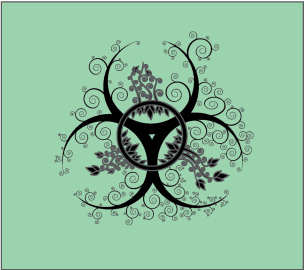
© Khabirov Ruslan/shutterstock
Metabolic Toxins
What are metabolic toxins? They are chemicals that impair or disrupt metabolic pathways. As you have studied in Module 5, both photosynthesis and cellular respiration are metabolic pathways. A metabolic toxin will target the function of chloroplasts or mitochondria.
Science has moved technology toward creating pesticides and herbicides that interfere with the metabolic processes of organisms and ultimately cause death. Scientists must use the scientific process to determine harmful effects on humans and desired effects on pests and weeds. Metabolic toxin research may also help scientists discover ways to inhibit cancer cell growth by creating toxins that specifically inhibit cellular respiration in cancer cell mitochondrion that cause the cancer cells to die.
 Try This
Try This
TR 1. The Effects of Metabolic Toxins on Cellular Respiration
In this investigation you will be choosing one of the following metabolic toxins to investigate:
- antimycin
- cyanide
- hydrogen sulfide
- malonate
- oligomycin
- rotenone
- arsenic
You may have heard of arsenic or cyanide, and you may know that they are poisonous to humans as well.
You will be completing “Thought Lab 5.3” on page 189 of the textbook. You will be asked to research a metabolic toxin and create a Metabolic Toxin Profile based on the information you have collected. You can present the profile in a variety of formats such as slide show, poster, report, or podcast. You must, however, include an introductory paragraph that summarizes the results of your research. Post your profile in the discussion area so that other students can view your research results. You will be constructing a comparison chart between the toxin you chose to research and two toxins that other students have researched and posted in the discussion area. You will also be asked to complete analysis questions as well.
This activity and how you will be marked on it is outlined in your Assignment.
 Discuss
Discuss
Don’t forget to post your Metabolic Toxin Profile to the discussion area. Also be sure to read other postings so that you can complete your comparison chart.
1.38. Page 5
Module 5—Photosynthesis and Cellular Respiration
 Reflect and Connect
Reflect and Connect
After taking part in the scientific process and doing some research, are you able to make a list of how respiration research affects science, technology, and society? Create a list that can be posted in the discussion area and shared with other students.
 Reflect on the Big Picture
Reflect on the Big Picture
Investigating cellular respiration and photosynthesis allows you to explore ways in which technology has benefited humans. Both processes are complex and involve many steps. You can now describe how energy and matter flow through photosynthesis and cellular respiration.
 Self-Check
Self-Check
SC 1. Complete this Self-Check activity.
SC 2. The human body contains about 50 grams of ATP at any one time, and yet about 8 kilograms of ATP per hour are being produced. Explain the apparent discrepancy in this data.
 Self-Check Answer
Self-Check Answer
SC 2. Some of the ATP is being used to supply heat, energy for movement, and other life processes incessantly.
 Module 5: Lesson 7 Assignment
Module 5: Lesson 7 Assignment
Remember to submit the Assignment answers to your teacher as part of your Module 5: Lesson 7 Assignment.
1.39. Page 6
Module 5—Photosynthesis and Cellular Respiration
Lesson Summary
In this lesson you explored the following essential questions:
- How can you demonstrate quantitatively that germinating seeds consume oxygen?
- How do metabolic toxins affect cellular respiration?
Working through both investigations allowed you to take a more in-depth look at cellular respiration. By investigating oxygen consumption and heat production in germinating seeds, you took part in the scientific process that is used by scientists hoping to make great discoveries.
As you researched metabolic toxins, you saw how a knowledge of cellular respiration is essential when determining what may inhibit the functioning of a cell. This knowledge has applications in the industries of agriculture, food, and medicine.
Now that you have completed this module and unit, you will finish the Unit Assessment. The Unit Assessment can be found on the Unit Summary and Assessment file. It is a three-part assignment. You will be answering questions from the textbook, creating some multiple-choice questions, and looking at the effects of a herbicide on photosynthesis and cellular respiration. There will not be a module assessment because the module and unit assessments for this module have been combined.
1.40. Module Glossary
Module 5—Photosynthesis and Cellular Respiration
Module Glossary
acetyl CoA: an oxidized form of glucose
active transport: a process that requires energy from ATP to move substances against the concentration gradient
ATP (adensosine triphosphate): a high-energy phosphate molecule that provides and stores the energy required for cellular functions
ATP synthase: an enzyme that bonds free phosphates to ADP to form ATP
biofuel: ethanol produced during the fermentation of biomass
biogas: methane captured from animal waste that is used as fuel
Calvin-Benson cycle: the process in which photosynthetic organisms fix carbon from atmospheric carbon dioxide to produce carbohydrates
CAM: crassulacean acid metabolism (CAM photosynthesis); an elaborate carbon fixation pathway in some plants
carbon-dioxide fixation: a carbon atom in carbon dioxide is chemically bonded to a pre-existing 5-carbon compound in the stroma of the chloroplast
chemiosmosis: the process by which ATP is generated through the movement of protons down a concentration gradient
The protons move across the inner membranes to the mitochondrion and thylakoid membrane of the chloroplast and combine with ADP and phosphate molecules to form ATP.
diffusion: a process in which molecules move from areas of high concentration to low concentration
endocytosis: a process in which cell membranes engulf a substance and pinch off inside the cell
exocytosis: a process in which a vacuole containing substances from inside a cell (cytoplasm) fuses with the cell wall and the contents are released outside of the cell
facilitated diffusion: a process in which larger molecules need the help of proteins in cell walls to move from areas of high concentration to low concentration
FADH2: an important coenzyme produced during Krebs cycle
It acts as an electron donor to the electron transport system involved in the production of ATP.
glucose: a saccharide or sugar; can be linked to many other saccharides to form different types of sugars or carbohydrates
glycolysis: a metabolic pathway in which one glucose molecule is broken down to form two, 3-carbon molecules and a small amount of ATP
Glycolysis is the first step in both anaerobic and aerobic respiration.
Krebs cycle: a metabolic pathway consisting of a series of reactions that break down the end products of glycolysis, producing carbon dioxide and generating a large amount of ATP; also know as the citric acid cycle; named after the 1953 Nobel Prize winning scientist who made the discovery
metabolism: all of the chemical reactions that occur within a cell to support and sustain its life functions
This can be the synthesis of molecules or the breaking down of molecules for energy.
NADH: a high-energy electron carrier
It acts as an electron donor to the electron transport system involved in the production of ATP.
NADP+: nicotinamide adenine dinucleotide phosphate in its oxidized state
NADPH: nicotinamide adenine dinucleotide phosphate in its reduced state; used in light-independent reactions to form glucose
osmosis: the diffusion of water across a semipermeable membrane
oxidation: a loss of electrons
passive transport: no energy required
phagocytosis: a process in which the cell wall engulfs a large particle, such as bacteria or a blood cell, and pinches off inside of the cell
phosphoglyceraldehyde (PGAL): a high-energy compound used to make glucose
phosphorylation: the process of adding a phosphate to a molecule; occurs in cellular respiration and photosynthesis
photosystem: a cluster of light-absorbing pigment molecules in the thylakoid membrane of chloroplasts
pinocytosis: a process in whichthe cell wall engulfs liquids and their solutes and pinches off inside the cell
proton: a hydrogen ion containing one electron
pyruvate: three carbon molecules produced by glycolysis
redox reaction: a reaction involving the transfer of electrons
reduction: a gain of electrons
reference flow: a measure of how far a substance is transported in chromatography
ribulose biphosphate (RuBP): a 5-carbon molecule in the stroma that initially bonds to carbon dioxide
thylakoid membrane: flattened stacks within the stroma that contain chlorophyll
VO2 max: used to measure how well an athlete is able to use oxygen during an activity: units are mL/kg/min